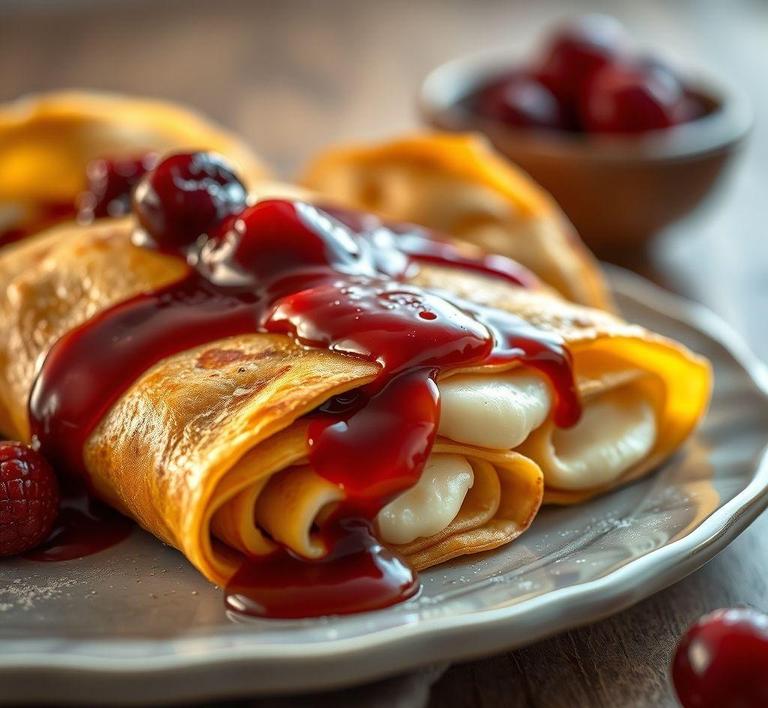Refreezing blintzes can be a bit of a tricky topic, but don’t worry – we’ve got you covered! Whether you’ve made a big batch of blintzes and have leftovers, or you just want to prepare ahead for a future meal, knowing how to properly refreeze them is key to keeping their texture and flavor intact. In this guide, we’ll walk you through the best methods to refreeze these delicious, stuffed crepes, ensuring that they stay just as tasty and fluffy when you reheat them as they were when they were first made. Let’s dive into the do’s and don’ts of freezing, refreezing, and reheating your blintzes without losing that perfect bite!
Can You Refreeze Blintzes?

Blintzes, the delightful thin, crepe-like pancakes traditionally filled with cheese, fruit, or other fillings, are a versatile dish. They are often prepared in large batches for special occasions or as a comforting breakfast. Like many other foods, it’s natural to wonder about the best ways to store blintzes and whether they can be refrozen once thawed. The simple answer is yes, you can refreeze blintzes, but it’s not always recommended. Let’s break down why this is the case and what factors to consider before doing so.
Blintzes are essentially delicate and moist due to their fillings, which can vary from creamy cheese to fruit jams or even savory combinations. When blintzes are frozen, they preserve the filling and their outer crispy texture relatively well, but thawing and refreezing can affect the overall texture and taste. The moisture from the filling can cause changes in the blintz wrapper and result in a less desirable final product.
In most cases, food safety is not an issue when it comes to refreezing blintzes, as long as they have been handled and stored properly. However, the loss of texture and flavor makes it something worth thinking about. The more times you freeze and thaw, the greater the potential for degradation of both the crust and filling. If your blintzes were thawed properly in the fridge and not left at room temperature for an extended period, refreezing is safe. However, quality loss is inevitable, especially if your blintzes contain dairy or other ingredients that don’t freeze well.
How To Refreeze Blintzes?
If you decide to refreeze your blintzes, you need to ensure you do so properly to maintain the best possible texture and taste. Follow these steps to give your blintzes the best chance of surviving a second freeze:
- Cool Completely: If you’ve already cooked the blintzes, it’s important to let them cool completely before refreezing. This prevents condensation from forming in the packaging, which would lead to ice crystals and negatively affect the texture.
- Wrap Individually: To prevent the blintzes from sticking together, it’s essential to wrap each one individually in plastic wrap, parchment paper, or aluminum foil. This will also protect them from freezer burn, which can cause a change in flavor and texture.
- Use an Airtight Container: After wrapping, place the individual blintzes in a freezer-safe airtight container or a heavy-duty freezer bag. Squeeze out as much air as possible to avoid freezer burn and prevent any odors from affecting the flavor of the blintzes.
- Label and Date: Always label your packaging with the date of freezing so you know how long the blintzes have been in the freezer. This also helps you track how many times they’ve been frozen.
- Freezing Method: Ideally, place the wrapped blintzes in a single layer on a baking sheet before putting them into the freezer. This allows them to freeze more quickly and evenly, reducing the risk of ice crystals forming inside. Once frozen solid, you can transfer them to their final storage container.
- Thawing and Reheating: When you’re ready to eat your refrozen blintzes, it’s important to thaw them properly. Thaw them in the refrigerator overnight instead of at room temperature to minimize bacterial growth. Once thawed, you can reheat them in a skillet over medium heat to restore some of their crispy exterior.
Quality Impact
Refreezing blintzes may compromise their quality in several key ways. While food safety is usually not a concern if they’ve been properly stored and handled, the impact on texture, flavor, and overall enjoyment can be significant.
- Texture Loss: The most noticeable change when refreezing blintzes is the texture of the wrapper. Freezing and thawing cause the crepe-like outer layer to become soggy or tough, depending on how much moisture is released from the filling. Blintzes with cheese or other dairy-based fillings are especially susceptible to this change. The moisture released from these fillings can soak into the wrapper, causing it to lose its delicate crispness.
- Filling Changes: The texture of the filling may also degrade when refrozen. Dairy-based fillings, such as those made with ricotta or cream cheese, may separate or become grainy after being frozen and thawed. Fruit-based fillings may suffer from water loss, leading to a more mushy or runny consistency. Savory fillings can also lose flavor intensity after being frozen and thawed multiple times.
- Flavor Alteration: Refreezing can dull the flavors of the filling. The longer the blintzes are frozen, the more likely they are to lose the fresh, vibrant flavors that come with fresh ingredients. The crispness of the outer shell, which is part of the blintz’s appeal, may also be lost, making the overall experience less enjoyable.
- Freezer Burn: If the blintzes aren’t sealed tightly or stored in an airtight container, they are susceptible to freezer burn. Freezer burn occurs when moisture from the food evaporates and is replaced by ice crystals, leading to dry, tough spots on the blintz. This can cause a decrease in both flavor and texture.
While you can refreeze blintzes, it’s not always the best choice if you want to preserve their original taste and texture. Freezing and thawing multiple times will almost certainly alter the delicate balance of the crepe wrapper and the filling, leading to potential sogginess, toughness, or changes in flavor. If you do decide to refreeze, make sure you take steps to store them properly by wrapping them individually, using an airtight container, and labeling them with the date.
For the best quality, it’s advisable to only freeze blintzes once. If you’ve thawed them already, try to consume them within a short period of time to enjoy their full flavor and texture. While refrozen blintzes can still be enjoyed, their quality won’t be quite the same as when they are freshly made. So, if you’re looking for that perfect bite, fresh is always best!
Is It Safe To Refreeze Blintzes?
Blintzes, those delicate, savory or sweet-filled crepes, are a beloved dish in many kitchens. Whether you’ve made them yourself or bought them pre-made, it’s not uncommon to have leftovers. However, the question of whether it’s safe to refreeze blintzes can be a bit tricky. The short answer is: it’s generally safe, but with caveats.
When you freeze blintzes, you’re slowing down the spoilage process, preserving their taste and texture for later consumption. However, every time food is frozen, thawed, and refrozen, the quality of the food diminishes. Blintzes, in particular, are quite sensitive to freezing and thawing due to their thin crepe shells and soft, often dairy-filled fillings.
The real issue with refreezing blintzes revolves around texture changes. Each time they go through a freezing cycle, the water content in the filling forms ice crystals. When thawed, these ice crystals can cause the fillings to become soggy or mealy. The crepes themselves can also lose their delicate structure, turning from soft and tender to tough and rubbery.
However, if you’ve stored your blintzes correctly, refreezing once shouldn’t pose a health risk, assuming they haven’t been sitting out at room temperature for long periods during the thawing process. Food safety is key: as long as the blintzes were kept at safe temperatures and haven’t been left in the ‘danger zone’ (40°F to 140°F, which promotes bacterial growth), you can safely refreeze them.
Signs That Blintzes Should Not Be Refrozen
Despite the possibility of refreezing, certain conditions can make refreezing blintzes unsafe or undesirable. Here are some clear signs that they should not be refrozen:
- Signs of Spoilage: If the blintzes have been thawed for too long or have been exposed to high temperatures, they may have begun to spoil. Look for any odd smell, discoloration, or signs of mold. These are clear indicators that the food is no longer safe to eat, and refreezing won’t reverse the damage.
- Thawing at Room Temperature for Extended Periods: If your blintzes have been left out on the counter for longer than two hours (or one hour if it’s particularly hot), they may have entered the ‘danger zone’ where bacteria grow rapidly. This makes refreezing unsafe. Always make sure they’ve been kept at a safe temperature (under 40°F) during the thawing process.
- Excessive Moisture or Sogginess: If the blintzes have become watery or overly soggy due to improper wrapping or long exposure to moisture, they may lose their texture even further when refrozen. If the crepes have broken apart or the filling has leaked, it’s best to discard them rather than refreeze.
- Previous Refreezing: If the blintzes have already been frozen, thawed, and refrozen once before, it’s best not to refreeze them a second time. Multiple cycles of freezing and thawing only exacerbate the texture issues and increase the risk of foodborne illness.
Common Refreezing Mistakes
When it comes to refreezing blintzes, a few common mistakes can lead to poor results. Here are some to watch out for:
- Not Properly Wrapping Blintzes: Blintzes need to be wrapped tightly in plastic wrap or aluminum foil, then placed in an airtight freezer bag or container. If they are not sealed well, freezer burn can occur, leading to dried-out or discolored patches on the crepes. The loss of moisture can also severely affect both taste and texture.
- Refreezing Without Fully Cooling: After thawing, if blintzes are not allowed to cool completely before refreezing, condensation can form inside the packaging. This extra moisture can create freezer burn or sogginess. Always ensure blintzes are completely cooled to room temperature before refreezing.
- Freezing In Too Large a Batch: It’s tempting to freeze a large batch of blintzes at once, but this often leads to the need to thaw and refreeze all of them at once. Instead, portion out smaller batches or freeze them individually on a tray before storing them in larger containers. This way, you only thaw what you need.
- Not Labeling Packages: It’s easy to forget when something was frozen, especially if you’re storing multiple items. Label your blintzes with the date they were frozen. Ideally, blintzes should be consumed within 2-3 months for the best taste and texture.
- Thawing in Warm Conditions: Thawing blintzes at room temperature or in hot water is a big mistake. This can accelerate bacterial growth. Thaw them in the fridge overnight or reheat them directly from the freezer for the best results.
Tips And Tricks
If you’ve decided to freeze and potentially refreeze your blintzes, here are some tips and tricks to help maintain their quality:
- Flash Freezing: Before storing your blintzes in a container, flash freeze them by placing them in a single layer on a baking sheet in the freezer for a few hours. This prevents them from sticking together, allowing you to pull out just one or two when needed.
- Reheat Straight from the Freezer: Instead of thawing your blintzes before reheating them, consider cooking them straight from the freezer. You can either pan-fry or bake them, which can help retain their structure. The heat from cooking will make them crispier and more enjoyable than if they were thawed first.
- Consider Cooking Before Freezing: If you’re freezing blintzes that have been made with perishable fillings like cheese or meat, you can consider cooking them first. This can make it easier to store them and ensures that they are safe to eat after being frozen.
- Use Freezer-Safe Containers: Opt for containers designed for long-term freezing, such as vacuum-sealed bags or heavy-duty freezer containers. These will provide an airtight seal and help preserve the blintzes’ quality.
- Control the Filling: When making blintzes, consider the filling type. Dairy-based fillings (like cream cheese or ricotta) tend to fare poorly when frozen and refrozen multiple times. Consider using fillings with a firmer consistency, like fruits or cooked vegetables, if you plan to freeze and refreeze.
Conclusion
Refreezing blintzes can be a convenient way to preserve leftovers, but it’s not without its pitfalls. While it’s safe to refreeze blintzes under the right conditions, the process can lead to texture changes and potential loss of flavor. The key is to ensure that the blintzes have been properly stored, thawed, and reheated to maintain the best quality.
To minimize common mistakes and maximize freshness, remember to wrap them tightly, avoid multiple cycles of freezing and thawing, and only refreeze blintzes that have not shown signs of spoilage. With the right care, refreezing can be a viable option for enjoying this delicious dish down the line without sacrificing too much of its original charm.


